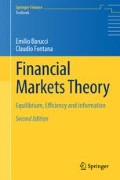Abstract
This chapter briefly reviews the fundamentals of decision making in a certain environment. Starting from a discussion of preference relations, the agent’s utility maximization problem is introduced and the concepts of general equilibrium, Pareto optimality and aggregation are explained.
All theory depends on assumptions which are not quite true. That is what makes it theory. The art of successful theorizing is to make the inevitable simplifying assumptions in such a way that the final results are not very sensitive. A “crucial” assumption is one on which the conclusions do depend sensitively, and it is important that crucial assumptions be reasonably realistic. When the results of a theory seem to flow specifically from a special crucial assumption, then if the assumption is dubious, the results are suspect. Solow (1956)
Once it has achieved the status of paradigm, a scientific theory is declared invalid only if an alternative candidate is available to take its place. No process yet disclosed by the historical study of scientific development at all resembles the methodological stereotype of falsification by direct comparison with nature. […] The act of judgement that leads scientists to reject a previously accepted theory is always based upon more than a comparison of that theory with the world. The decision to reject one paradigm is always simultaneously the decision to accept another, and the judgement leading to that decision involves the comparison of both paradigms with nature and with each other. Kuhn (1970)
Access this chapter
Tax calculation will be finalised at checkout
Purchases are for personal use only
Notes
- 1.
The set \(\mathbb{R}_{+}^{L}\) denotes the set of non-negative vectors and \(\mathbb{R}_{++}^{L}\) the set of strictly positive vectors with L elements.
- 2.
Given two vectors \(x,y \in \mathbb{R}^{L},\) the inequality x ≥ y means that \(x_{n} \geq y_{n}\ (\forall \,n = 1,\ldots,L)\), while x > y means that \(x_{n} \geq y_{n}\ (\forall \,n = 1,\ldots,L)\) with x ≠ y, and x > > y means that \(x_{n} > y_{n}\ (\forall \,n = 1,\ldots,L)\).
- 3.
Given a function \(f: \mathbb{R}^{N} \rightarrow \mathbb{R}\) of N real variables, the partial derivative with respect to the variable x i will be denoted by \(f_{x_{i}}\), while the partial derivative evaluated in \(x \in \mathbb{R}^{N}\) will be denoted by \(f_{x_{i}}(x)\).
References
Arrow, K. (1968) Economic equilibrium. International Encyclopedia of the Social Sciences. Crowell Collier & Macmillan, New York.
Hahn, F. (1973) On the Notion of Equilibrium in Economics. Cambridge University Press.
Ingrao, B. and Israel, G. (1987) La Mano Invisibile. Laterza, Roma.
Kuhn, (1970) The Structure of Scientific Revolutions. University of Chicago Press.
Mas-Colell, A., Whinston, M. and Green, J. (1995) Microeconomic Theory. Oxford University Press.
Solow, R. (1956) A contribution to the theory of economic growth. Quarterly Journal of Economics, 70:65–94.
Varian, H. (1984) Microeconomic Analysis. Norton, New York.
Author information
Authors and Affiliations
Rights and permissions
Copyright information
© 2017 Springer-Verlag London Ltd.
About this chapter
Cite this chapter
Barucci, E., Fontana, C. (2017). Prerequisites. In: Financial Markets Theory. Springer Finance(). Springer, London. https://doi.org/10.1007/978-1-4471-7322-9_1
Download citation
DOI: https://doi.org/10.1007/978-1-4471-7322-9_1
Published:
Publisher Name: Springer, London
Print ISBN: 978-1-4471-7321-2
Online ISBN: 978-1-4471-7322-9
eBook Packages: Mathematics and StatisticsMathematics and Statistics (R0)

